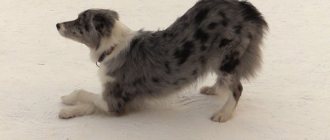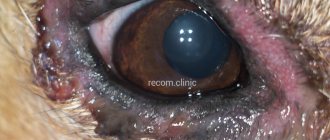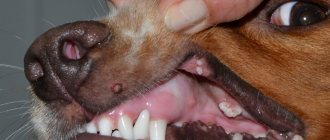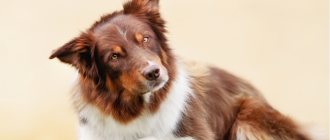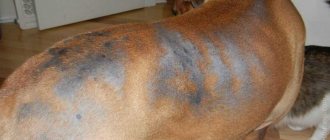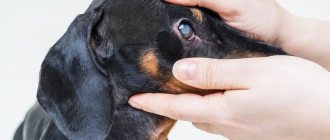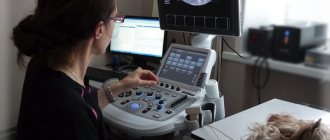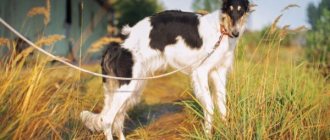What is joint dysplasia
Dog owners often ask the question, “What is joint dysplasia?” It is not difficult to explain the essence of what is happening, but the processes themselves are very complex and sometimes irreversible. The Greek word consists of two “dys” - disorder, and “plaseo” - education. This word can denote any pathology that occurs when tissue structure is disrupted and anomalies form . If we are talking about joints, then disorders occur in the bone and cartilage tissues of the articular surfaces.
If we consider, for example, the femoral joint, then the head of the femur should slide freely, easily and correspond to the acetabulum. However, with pathological changes in tissues, a discrepancy (discongruence) occurs. As a result, compression is observed in some places and friction in others. An inflammatory process develops in the cartilage tissue and periosteum. Any physical effort destroys cartilage tissue.
Determining the diagnosis of dysplasia
In medical terms, hip dysplasia (HJ) is a deformity of the acetabulum. A large gap forms between the glenoid cavity and the head of the bone. When moving, the bone begins to fit incorrectly to the joint and rub against it. As a result, bone tissue delaminates, changes its structure, and becomes brittle. The disease leads to partial or complete destruction of joint tissues and loss of motor functions.
Veterinarians distinguish 5 categories of disease:
- A – absence of pathologies, joint tissue without damage.
- B – there is a predisposition to TBS.
- C – dysplasia at the initial stage.
- D – moderate severity.
- E – severe condition, bordering on osteoarthritis.
By detecting hip dysplasia in time and starting proper treatment, the severity of the disease can be reduced, degenerative processes can be stopped, and the suffering of the animal can be alleviated.
Congenital and acquired dysplasia
There is ongoing debate about how genetically dependent joint dysplasia is. It has been repeatedly proven that the disease is not congenital.
However, arguing about when congenital and acquired dysplasia begins, researchers provide strong arguments in favor of the fact that the pathology originates in the prenatal period.
Research continues both in veterinary medicine and in pediatrics and orthopedics. Perhaps in the near future the truth will be revealed.
Treatment of hip dysplasia with drugs from Heel
A treatment regimen for German shepherds, developed by German veterinary specialists and having repeated positive results in young dogs (not all Heel veterinary drugs presented can be purchased in our country).
- Placenta compositum and Coenzime compositum are administered in one syringe, subcutaneously, in a dosage of 2.0 ml of each, once a week, 5-10 injections, more if necessary, until the condition is completely normalized.
Placenta increases blood supply to tissues, and Coenzime compositum releases and stimulates blocked enzyme systems in degenerative diseases, as well as in case of insufficient enzyme function in the cellular phase of pathology.
- Calcoheel – orally, one tablet, five times a day, every day, to normalize calcium metabolism and compensate for the lack of calcium in the body.
Composition of Calcoheel: Calcium carbonicum Hahnemanni, Dulcamara,
Chamomilla, Carbo vegetabilis.
- Molibden compositum – 1 tablet each. per day, every day, to normalize and stabilize mineral metabolism.
In severe cases, to reduce pain and improve the quality of life of the animal, surgical intervention is used, and in especially severe cases, surgical removal of the femoral head is used, which reduces the pain effect and prevents lameness.
At the same time, the use of homeopathic veterinary drugs both before and during the postoperative period can significantly reduce the risk of complications and shorten the recovery period after surgery.
Causes of dysplasia in dogs
The reasons for the development of dysplasia are not clear. The researchers came to the conclusion that a lot depends on the ligamentous apparatus. For example, the round ligament must hold the head of the femur in the joint at a time when the muscular corset is just forming in a growing dog. However, this sometimes does not happen.
The cause of early dysplasia is considered to be injuries associated with weakness of the ligamentous apparatus.
Processes can be slow and hidden. Sometimes the owner cannot even describe the situation that preceded the appearance of clinical signs. Symptoms appear when the femoral head is completely out of the socket (dislocation), and the dysplasia itself has developed long before the clinic.
The causes of dysplasia in dogs can be varied and continue to be studied. Specialists tend to highlight two special aspects:
- Low physical activity (starting from puppy age). This leads to a slow accumulation of muscle mass, which leads to weakness of the corset, underdevelopment of bone and joint tissues;
- Imbalanced diet. An excess of carbohydrates leads to rapid weight gain. The dog grows and the owner rejoices. However, being overweight is not the same as having a strong, well-developed muscular system. In addition, excess weight places unnecessary burden on the joints, which also leads to pathology.
Causes
Research shows that heredity remains the main factor. Typically, puppies whose parents have the same joint problems are susceptible to pathology. However, not in all cases the offspring suffer from dysplasia. It has not yet been possible to determine the pattern completely unambiguously.
External reasons should also include:
- poor nutrition (mainly cheap feed);
- excess in the diet of foods containing potassium and phosphorus;
- overeating and resulting obesity;
- systematic excessive physical loads (especially at a young age);
- injuries.
Life expectancy of dogs with dysplasia
Dysplasia develops in different ways. The speed of development is influenced by many factors. It should be taken into account that the development of the musculoskeletal system in a dog is formed in the first year of life and is almost complete by 18 months. During this period you should not allow:
- heavy loads;
- taking on high obstacles;
- static overloads.
The life expectancy of dogs with dysplasia is difficult to determine. There are cases when the disease went into remission and the dog lived up to 14 years. A completely different issue is quality of life. When a dog constantly limps, tries to lie down, and does not want to go for a walk, this brings discomfort into the life of the animal and the owner. If you set a goal to treat the animal as carefully as possible, provide high-quality feeding, and thoughtful walking, then the animal will live its allotted time, despite joint dysplasia.
Main varieties
Pathology is divided according to the stages of disease development:
- And the degree. The disease does not manifest itself;
- To the degree. This category includes a disease when the head of the bone occupies an anatomically correct position (deep), but the cup holding the head is somewhat flat;
- C degree. In this case, the articular surfaces have a strong articulation, but there are already noticeable irregularities on the head, and the plane of the cup is already clearly expressed. If this pathology is detected, the animal is not allowed to reproduce;
- D-E degree. In these cases, the line of transition from one degree to another is very thin. The joint is in the stage of dislocation. The joints are flat and in the stage of destruction.
Hip joint (hind limbs)
The processes occurring in the joints of the hind and forelimbs are very similar. The destruction of bone and cartilage tissue occurs mechanically. When articular surfaces extend beyond the boundaries of their anatomical spaces, a load is placed on a specific part. It is here that the inflammatory and destructive process develops.
Most often it is customary to talk about dysplasia as a process occurring in the hip joint.
Elbow and shoulder joint (forelimbs)
This pathology develops less frequently. However, if you notice in your dog:
- lameness in the forelimbs, especially after exercise;
- pain reaction when bending or straightening the paw;
- enlargement of the elbow joint area, swelling, pain, you should consult a doctor for an accurate diagnosis.
Age of onset of symptoms and their description
Noticeable signs appear at 1-1.5 years, but by this time the prognosis for the animal is disappointing. The diagnosis can be made earlier (at 4-7 months), but only with regular examination by a veterinarian. For this reason, it is recommended that dogs at risk undergo CT scans and x-rays for preventive purposes. This is the only way they can avoid complications such as osteoarthritis and paralysis.
For pathology of the hip joints
The disease is asymptomatic for a long time, complicating timely diagnosis. Most often, concerned owners consult a doctor when they experience pain in their hind legs. It can be easily identified by:
- refusal to climb stairs or jump on a sofa or into a car;
- discomfort that occurs even while sitting (the animal has difficulty changing positions);
- wagging the croup and relying on the forelimbs;
- lameness in one or both hind legs, worse after waking up;
- aggression shown by any attempt to touch the back of the body.
Signs and symptoms of hip dysplasia in dogs often appear with a long delay. This is explained by the chronic course of the disease and gradual adaptation to a mild pain syndrome.
For pathology of the knee joints
A rare form that develops after a knee injury. It differs from the previous one in the sudden onset of an acute attack of pain and ongoing discomfort even during sleep. The affected joints become deformed, causing noticeable lameness in the hind legs.
For pathology of the elbow joints
The only type of pathology when lameness occurs in the forelimbs. The dog avoids not ups, but downs. When walking on a hilly area, he will try to slide down the hill without moving his paws.
At an advanced stage, lumps appear on the elbows, and the sick pet takes very strange positions while sleeping. His forelimbs move in different directions, since bending them under himself causes very severe pain. Any unfortunate touch from the owner causes similar discomfort.
Symptoms and first signs of dysplasia in dogs
By carefully monitoring your pet, you can notice the first manifestations of pathology already in the first months of life.
Symptoms and first signs of dysplasia in dogs appear:
- caution when walking;
- lameness that appears and disappears;
- refusal to execute commands;
- stiffness in getting up after lying down, after sleep;
- desire to sit or lie down;
- refusal to climb stairs;
- reaction to touching the joint area;
- strange, noticeable movement, not typical for a dog.
Breed predispositions
Joint dysplasia is reported in almost all breeds. However, this pathology is most often observed in those animals that are characterized by rapid, rapid growth. Large breeds of dogs, which significantly increase in size in the first 5-6 months, are more susceptible to the disease. Dysplasia is the most common in these breeds.
Medium and large breed dogs
- Newfoundland;
- Golden retriever;
- Rottweiler;
- chow-chow;
- German Shepherd;
- Labrador;
- boxer.
Small breed dogs
Breed predispositions are less pronounced in small breeds. And statistics cannot give preference to any specific breeds.
Features of the disease
Deviations from the development of individual parts of the body, internal organs, and tissues of the body are called dysplasia.
Dysplasia in veterinary practice is a common orthopedic disease that affects large breed dogs, which include German shepherds. The disease causes a lot of inconvenience and suffering to the animal during physical development and growth.
The disease can spread extremely quickly if selection methods such as crossing close relatives and the lines they create are used in breeding German Shepherds.
The disease is divided into two types:
- hip dysplasia;
- elbow dysplasia.
Let's consider each disease separately.
Tests and methods for diagnosing dysplasia
Unfortunately, not all clinics can conduct research and make the correct diagnosis.
Very often, specialists diagnose dysplasia as a preliminary diagnosis and prescribe treatment.
Test for dysplasia in dogs
Tests and methods for diagnosing dysplasia are not multifaceted. Only an x-ray can make an accurate diagnosis.
Some breeders conduct a mobility test before allowing a dog to be bred. It should be noted that it cannot be an indicator and a professional x-ray examination must be carried out. However, many experts believe that the dog must be at least 2 years old.
X-ray of the joint
To conduct research you need:
- use sedatives;
- lay the dog on its back, the limbs should be extended and positioned strictly parallel;
- The image must be of sufficient size and include both the pelvic bones and the knee joints.
It is possible to examine the pathology in the image only if the image clearly shows the right and left blocks with evenly spaced articular surfaces. Particular attention should be paid to the upper edges of the acetabulum.
If there is no experience in performing radiography, the diagnosis may be made incorrectly. That is why, when contacting a clinic, you need to inquire about certification to conduct x-ray examinations.
No matter how well the various methods are described, they are not yet diagnostic in nature.
Diagnosis of dysplasia in puppies
Confirmation of the diagnosis is carried out in several stages.
- First, the doctor conducts an in-person examination, which includes palpation and examination of the diseased limbs. The paw must be bent and unbent to pay attention to whether there are clicking sounds in the joint. Their presence indicates the development of destruction of cartilage tissue.
- Prescribing an x-ray, which will allow you to make an accurate diagnosis, taking into account the deterioration of the tissue.
- Arthroscopy. The most informative procedure involves inserting a small chamber into the joint through a puncture. It is carried out only in professional clinics with modern equipment.
Attention! X-rays in dogs are often performed using general anesthesia. You should not be afraid of this and refuse such examination tactics. Since it is important to obtain a clear image for a correct diagnosis, the dog should be immobilized as much as possible.
Only an x-ray can confirm dysplasia
Treatment of joint dysplasia in dogs
The fact that the disease is difficult to treat remains a fact. Experts are constantly working on the problem.
Treatment of joint dysplasia in dogs can be carried out with medication and surgery.
Surgical intervention
Prompt assistance can be provided to those animals that have completed their growth and development, and also if other methods of ensuring joint mobility are not possible. The following methods can be chosen:
- Myectomy (excision) of the pectineus muscle. This will relieve pressure on the joint and reduce pain. The operation is performed only on young animals;
- Osteotomy of the femoral neck and head. Positive results in 35%; for the rest, the intervention alleviates the condition, but does not eliminate the pathology. Can be done at any age;
- Triple osteotomy. Complex intervention. In this case, the bones of the acetabulum are dissected. To ensure that the joint is fixed, it is covered with a plate. It is carried out only on young animals. If tissue regeneration is insufficient (older dogs), surgery will be unsuccessful;
- Interacetabular osteotomy. It is carried out only on young animals. To change the angle of inclination, a portion of the bone tissue is excised (removal of a wedge), followed by closure with a plate.
Conservative treatment methods
It is impossible to completely recover from pathology using conservative methods, but with their help you can slow down the development of the disease. With stable remission and proper care, the average life expectancy characteristic of the breed of the sick animal can be preserved.
Conservative treatment of dysplasia in dogs is based on taking medications, attending physical procedures and using compresses. All these measures are effective only at an early stage.
Drug therapy
The medications prescribed by your doctor will have to be taken for life. These include:
- chondroprotectors that restore joint tissue;
- anti-inflammatory or glucocorticosteroids that relieve inflammation;
- antispasmodics and analgesics that eliminate spasms and pain.
In addition to the listed medications, vitamin and mineral complexes with chondroitin and glucosamine are used. These dietary supplements normalize limb mobility, strengthen ligaments, stimulate metabolic processes and improve tissue regeneration.
Physiotherapy
Non-surgical treatment of hip dysplasia in dogs is not complete without physiotherapy. These include:
- magnetic laser therapy;
- electrophoresis;
- ozokerite treatment;
- acupuncture;
- paraffin therapy;
- paw massage
All of these procedures are aimed at reducing pain, eliminating inflammation and strengthening joint tissue. In addition, veterinarians recommend signing up for swimming or therapeutic exercises.
Compresses
Traditional medicine is ineffective, so it should be used only as part of complex therapy. Baths with medicinal herbs, compresses of boiled potatoes and cabbage leaves with honey will help relieve pain.
Consequences of the disease
Unfortunately, it cannot be said that this disease is curable. Animals remain at risk forever.
Some pets show no symptoms of pain. However, the owner must understand that the process is reversible, so supportive therapeutic drugs should always be available.
The consequences of the disease impose certain rules of behavior, walking and exercise, methods and methods of feeding. Constant attention to gait and weight control will help prevent exacerbation.
Prevention measures
To prevent the occurrence of the disease, it is necessary to take preventive measures.
Diet and feeding ration
Feeds should be balanced, low in carbohydrates and high in proteins and minerals. Particular attention should be paid to complementary feeding up to 8 weeks. Puppies need meat, fish, milk, fermented milk cheese and chewable bones. Overfeeding with carbohydrates should not be allowed. Cereals and legumes, potatoes, and flour products should be excluded from the diet.
Weight control in older dogs
Age cannot be turned back. For a mature animal, weight control is the basis of health. Overeating should not be allowed. Carbohydrates should be excluded from the diet.
Exercises and stress on joints
Statistics indicate that raising a puppy from early childhood by walking without a leash on uneven ground (park, forest, field) is the best prevention. Do not restrict movement with a leash, do not walk on slippery, icy areas, or force the puppy to walk up stairs.
Important! Constant exercise, games, and walking stimulate the development of muscles, not joints. They play the main role.
When walking an animal, the owner must constantly monitor the animal’s gait, both fast and slow. As soon as the first signs of lameness become noticeable, you should not postpone a visit to the doctor.
Preparations for mineral balance
As preventive measures, to balance minerals in the diet, you can use the following drugs:
- arthrovet complex;
- artroglycan;
- arthrofitis;
- biolysin arthro;
- gelakan.
The composition of the preparations includes chondroitin, hyaluronic acid, mineral complexes and vitamins. The use of such drugs at the age of formation of the musculoskeletal system is especially important.
Proper nutrition
Photo from player.ru
A lot depends on nutrition. The dog’s diet should consist of balanced components, which in a single cocktail organically complement each other, trigger the processes of development and enrichment of the body with vitamins and minerals.
One of the common mistakes that breeders make: Special reduction in calories (replacing protein with carbohydrates). This measure is used to force the puppy's growth to slow down as a way to prevent dysplasia. But such actions only harm the dog’s body. Especially during the period of its active development. The diet leads to the opposite effect - the animal rapidly gains weight. And extra pounds are a serious threat to the occurrence of dysplasia.
Basics of proper nutrition
- Avoid diets. The dog should receive proteins, fats, and carbohydrates.
- Cook the broths. Liquid food stimulates secretion, quickly saturates and is easily digested.
- Introduce calcium and phosphorus into your diet. Only in a duet will calcium work effectively and strengthen bones and joints.
- From the very first weeks of life, add supplements with glucosamine and chondroitin to the diet, which prevent the appearance of dysplasia.
- Choose food enriched with all the necessary vitamins, minerals, and probiotics. Select according to the dog's age and weight. Foods for large breeds are produced according to their own formulas, which differ from pet food for small dogs.
Monitor your dog's weight and don't make him obese! Extra pounds are a threat to hip dysplasia.

